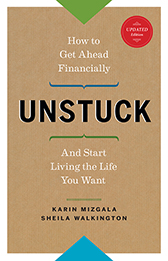By Karin Mizgala, Co-Founder and CEO Money Coaches Canada

The volume of financial advice at our fingertips is unprecedented. Through the phones in our pockets, we have access to newspapers, magazines, financial blogs, podcasts, videos and hundreds of books from financial writers around the globe.
While Canadians certainly have more financial information at hand, are we really any better informed? I’m not so sure. In my day-to-day conversations with clients, I am dismayed by the lack of understanding they have about critical components of prudent investing. And it’s not their fault!
Let’s face it, while there have been some changes to requirements for more transparency and disclosure, it hasn’t gone far enough – not by a long shot. The investment world still has a vested interest in keeping investors in the dark and many misconceptions abound.
Some of these misconceptions are:
- Investment Fees Don’t Matter
- Past Returns are an Indication of Future Success
- Advice You Receive from Your Investment Advisor is Free
Let’s have a look at each one.
Investment Fees Don’t Matter
If you follow financial news, you’ve no doubt heard of CRM2 (the second phase of the Client Relationship Model, established by Canadian Securities Administrators). Among other things, it was established to create better transparency around investment fees.
Creating more transparency was important because the regulators understand that fees matter. But the average investor, after hearing time and again that Canada ranks poorly on the world stage when it comes to investment fees, risks becoming apathetic to the idea that they have any influence over the fees they pay.
 But passively accepting fees as simply the cost of investing is a myth that serves only those who sell investments that don’t deliver. It may not sound consequential, but the 2.5 per cent that many Canadians are paying (after management fees, commissions and embedded trading costs are all considered), can send a shockwave through their retirement goals.
But passively accepting fees as simply the cost of investing is a myth that serves only those who sell investments that don’t deliver. It may not sound consequential, but the 2.5 per cent that many Canadians are paying (after management fees, commissions and embedded trading costs are all considered), can send a shockwave through their retirement goals.
Here is an example that we’ve shared before, but bears repeating:
In this scenario, you are a 50-year-old, with $450,000 in your investment portfolio, saving for 15 years and aiming for a 4-per-cent average annual return. That will grow to $810,425 over that 15-year span (with no additional contributions for ease of calculation). If we can bump that rate of return to 5 per cent, by dropping fees to 1.5 per cent from 2.5 per cent over that span, that would increase the investment value to approximately $935,518.
That’s $125,000 more towards your retirement. I’d say that matters. Just imagine what you could do with that money over your retirement years. And that calculation was based on 15 years. The impact will be even greater the longer you have until retirement.
It is true that there is no way around paying some level of fees for investment management, but unlike the return on investment, fees are something you can take some control over. Understand what fees you’re paying. Ask questions, negotiate fees, change investment strategies, or even investment advisors. Don’t assume you can’t do better.
Past Returns Are an Indication of Future Success
Everyone wants assurance that the investments they make will be good ones, or even better, great ones. That’s why investment funds are often sold on the basis of historical data, a technique known as back-testing, to demonstrate the soundness of the investment.
The idea, simply stated, is to show how this fund or pool would have performed if it had launched 10 years ago. If the fund “proves” to have done well over that hypothetical period, then it’s “safe” to say that it’s a strategy that has merit moving forward.
That assumption can be costly.
There are lots of factors that can influence the results of back-testing, not least of which are the biases in the data used. Here is a quote from Investopedia.com:
“The ideal back-test chooses sample data from a relevant time period of a duration that reflects a variety of market conditions. In this way, one can better judge whether the results of the back-test represent a fluke or sound trading.”
 “The historical data set must include a truly representative sample of stocks, including those of companies which eventually went bankrupt or were sold or liquidated. The alternative, including only data from historical stocks that are still around today, will produce artificially high returns in back-testing.”
“The historical data set must include a truly representative sample of stocks, including those of companies which eventually went bankrupt or were sold or liquidated. The alternative, including only data from historical stocks that are still around today, will produce artificially high returns in back-testing.”
While there can be some merit to looking at how the performance of individual stocks or funds have stacked-up against their respective market benchmarks, the real key to long term investment success is having a diversified and balanced portfolio that meets your individual goals. One that will allow you to ride out the inevitable waves, cycles and trends of the market.
Advice You Receive from Your Investment Advisor is Free
Despite the requirements for fuller fee disclosure, there is still much about fees and advisor compensation that is misleading and confusing to the average investor. Some of my clients are still saying that they don’t pay fees to the bank or their advisor for investment management and financial planning advice. Even if the fee isn’t explicit, you can be sure that there is one.
Commissions and investment fees often go undiscussed and are simply embedded in the cost of the product. And as we saw in the first misconception, these costs can be far from inconsequential.
 No matter how confident you are that your advisor is doing a good job for you, be sure you understand how he or she is being paid, and how that could influence their investment recommendations and financial planning advice.
No matter how confident you are that your advisor is doing a good job for you, be sure you understand how he or she is being paid, and how that could influence their investment recommendations and financial planning advice.
The commissioned-based model is the most common in the financial-services industry. While upfront sales commissions may be phased out, advisors receive a ‘trailing commission’ which compensates them for providing ongoing advice and service. Advice and service many people aren’t offered or don’t even take advantage of beyond an annual check-in.
It isn’t inherently wrong that advisors are paid fees and commissions, but it’s important to make sure you know what you are paying, get what you pay for, and that the fees you pay are the best value they can be for the size of your portfolio.
Don’t Let Misconceptions Hurt Your Investing Success
You can’t control the rate of return on your investments, nor can you control tax rates or the effects of inflation on your financial growth, but you can avoid getting trapped by investment myths.
Remember:
- Investment fees matter, don’t just accept the status quo
- Don’t invest based on market assumptions and past performance, take a balanced, long term approach to investing
- Make sure you understand how your financial advisor is being paid and how this might impact the investment and planning advice you are receiving
Most importantly, even if you do work with an investment advisor, be sure you are delegating not abdicating responsibility to them. You need to ask the right questions and monitor key elements such as: fees, rate of return and whether your investments are on track to meet your goals.
If you are interested in getting a second opinion on your investments, a Money Coaches Canada Investment Coach can help.
The On Your Side Investment Report Card™ is a visual, easy to understand, action-oriented report that helps you make sure that your investments are being managed with only your best interests in mind.
Click here to learn more.


